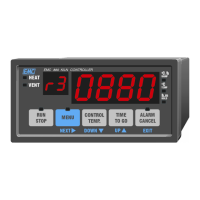
Do you have a question about the EMC 880 and is the answer not in the manual?
| Brand | EMC |
|---|---|
| Model | 880 |
| Category | Controller |
| Language | English |
Explains the manual's structure and how to use it for quick information retrieval.
Crucial pre-firing checks, including thermocouple matching and ambient temperature.
Details on creating a temperature profile and entering program values for a bisque firing.
Step-by-step guide to saving a bisque firing configuration as Program 1.
Instructions for initiating a firing immediately after programming.
Method to schedule a firing to begin after a specified time delay.
Covers general operation, entering/selecting programs, and setting ramp rates.
Setting target temperatures, hold times, and vent points for program stages 1-6.
Setting vent open points and initiating firings via instant or delayed start.
Starting a firing from a specific stage and monitoring/adjusting settings during an active firing.
Details the purpose and operation of the RUN STOP, MENU, Control Temp, and Time To Go keys.
Usage of the Alarm Cancel key and explanation of various indicator lights.
Details on how the large and small displays present information during operation.
Explains small display functions, beeper signals, and the power-up test sequence.
Describes how the controller behaves and recovers after a power interruption.
Detailed list of alarm codes, their causes, and recommended remedies for troubleshooting.
Procedures for diagnosing faults and a list of common issues with solutions.
Physical dimensions, mounting, and critical advice on separating power and thermocouple cables.
General wiring guidelines and electrical interference suppression.
Connecting power and suppressing electrical interference for reliable operation.
Details on Heat, Run, and Vent relay functionalities and wiring.
Information on Alarm Relay, Thermocouple, and Resistance Thermometer wiring.
Procedure to enter field settings mode and a summary table of all settings.
How to select and set the input sensor type (Thermocouple or RTD).
Configuring demo mode, auto-continue, and setting temperature limits for holds.
Setting timeout for loss of control alarms and configuring the automatic simmerstat feature.
Overview of program parameters, input sensor types, and other configurable settings.
Details on outputs, housing, environment, power supply, and ordering.